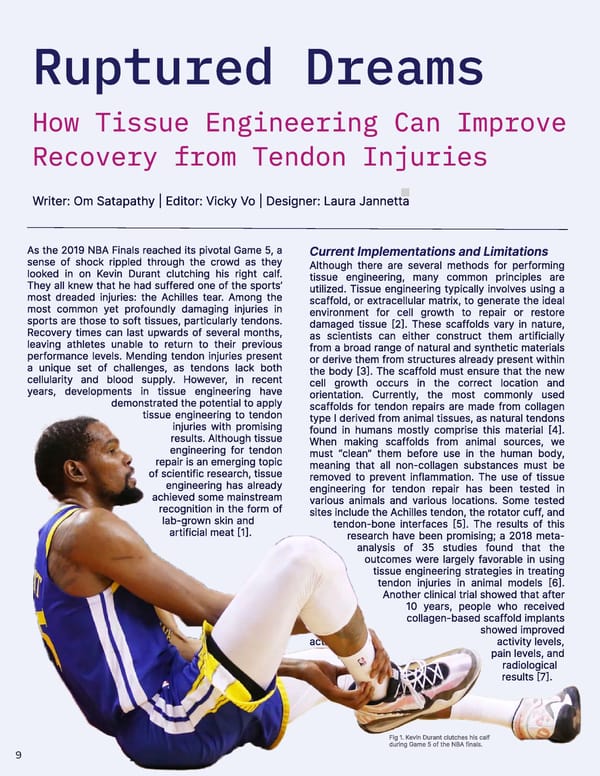Ruptured Dreams How Tissue Engineering Can Improve Recovery from Tendon Injuries Writer: Om Satapathy | Editor: Vicky Vo | Designer: Laura Jannetta As the 2019 NBA Finals reached its pivotal Game 5, a Current Implementations andLimitations sense of shock rippled through the crowd as they Although there are several methods for performing looked in on Kevin Durant clutching his right calf. tissue engineering, many common principles are They all knew that he had suffered one of the sports’ utilized. Tissue engineering typically involves using a most dreaded injuries: the Achilles tear. Among the scaffold, or extracellular matrix, to generate the ideal most common yet profoundly damaging injuries in environment for cell growth to repair or restore sports are those to soft tissues, particularly tendons. damaged tissue [2]. These scaffolds vary in nature, Recovery times can last upwards of several months, as scientists can either construct them artificially leaving athletes unable to return to their previous from a broad range of natural and synthetic materials performance levels. Mending tendon injuries present or derive them from structures already present within a unique set of challenges, as tendons lack both the body [3]. The scaffold must ensure that the new cellularity and blood supply. However, in recent cell growth occurs in the correct location and years, developments in tissue engineering have orientation. Currently, the most commonly used demonstrated the potential to apply scaffolds for tendon repairs are made from collagen tissue engineering to tendon type I derived from animal tissues, as natural tendons injuries with promising found in humans mostly comprise this material [4]. results. Although tissue When making scaffolds from animal sources, we engineering for tendon must “clean” them before use in the human body, repair is an emerging topic meaning that all non-collagen substances must be of scientific research, tissue removed to prevent inflammation. The use of tissue engineering has already engineering for tendon repair has been tested in achieved some mainstream various animals and various locations. Some tested recognition in the form of sites include the Achilles tendon, the rotator cuff, and lab-grown skin and tendon-bone interfaces [5]. The results of this artificial meat [1]ਠ嘀 research have been promising; a 2018 meta- analysis of 35 studies found that the outcomes were largely favorable in using tissue engineering strategies in treating tendon injuries in animal models [6]. Another clinical trial showed that after 10 years, people who received collagen-based scaffold implants im showed improved activity lev activity levels, pain levels, an搀 . radiological results [7]. results [7]. Fig 1. Kevin Durant clutches his calf during Game 5 of the NBA finals. 9
 Penn Healthcare Review Fall 2023 Journal— Sports Medicine Page 13 Page 15
Penn Healthcare Review Fall 2023 Journal— Sports Medicine Page 13 Page 15